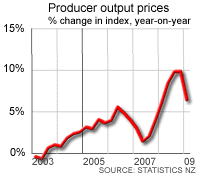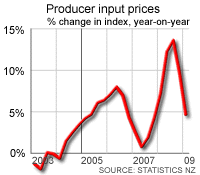 By BNZ Markets Senior Markets Economist Craig Ebert This morning's economy-wide producer price data looked highly inflationary. However, because it mainly reflected transitory spikes in isolated areas, we wouldn't read too much into it. Sure, the very high headline PPI inflation, and the stubborn pace under the surface, is a rude reminder of the need for the economy to keep slowing down. But it doesn't change our macro view to any material degree.
By BNZ Markets Senior Markets Economist Craig Ebert This morning's economy-wide producer price data looked highly inflationary. However, because it mainly reflected transitory spikes in isolated areas, we wouldn't read too much into it. Sure, the very high headline PPI inflation, and the stubborn pace under the surface, is a rude reminder of the need for the economy to keep slowing down. But it doesn't change our macro view to any material degree.  Most notably, the 3.5% increase in Q2 output prices and 5.6% for inputs were further inflamed by approximate 50% spikes in wholesale electricity spot prices. This was a direct consequence of the drought, as generation companies rationed supply amid hydro lakes dropping to crisis levels. These were extreme times, with the rationing working through extreme prices. Better that than directly enforced rationing of electricity, as tended to be the case during lake level crises in years past. Oil prices also featured very strongly, yet again, in the Q2 PPI results – directly visible through the wholesale trade category (which includes oil companies) and indirectly by way of transport costs and the like. Since the June quarter, of course, oil prices have fallen quite a bit (for a change) amid a broader correction in international commodity prices, and spot electricity prices have almost halved. Such things should remove as much from the Q3/Q4 PPI as they added over the first half of 2008.
Most notably, the 3.5% increase in Q2 output prices and 5.6% for inputs were further inflamed by approximate 50% spikes in wholesale electricity spot prices. This was a direct consequence of the drought, as generation companies rationed supply amid hydro lakes dropping to crisis levels. These were extreme times, with the rationing working through extreme prices. Better that than directly enforced rationing of electricity, as tended to be the case during lake level crises in years past. Oil prices also featured very strongly, yet again, in the Q2 PPI results – directly visible through the wholesale trade category (which includes oil companies) and indirectly by way of transport costs and the like. Since the June quarter, of course, oil prices have fallen quite a bit (for a change) amid a broader correction in international commodity prices, and spot electricity prices have almost halved. Such things should remove as much from the Q3/Q4 PPI as they added over the first half of 2008.  The other area where headline gains were overstating the fundamental story was in agriculture. To be sure, price increases for sheep and beef during Q2 started to pick up on a good news story that has only become stronger in Q3. However, there is an offset here in that meat prices are bound to be supported by the lower supply forecast for the coming season, especially as a consequence of the sizable culling of the breeding ewe stock over the first half of 2008. Dairy producers are looking at even more robust revenue. From prices holding at strong levels in Q2 (in line with the $7.90 dairy payout announced for the 2007/08 season), the indicated payout for the coming season of $7.00 has upside, in our estimation, and production will rebound noticeably increasing following last season’s drought. However, it is true for the dairy sector, as it is for most every other farming enterprise, that farm input costs, in general, have been clawing back a big chunk of the top-line revenue gains. The Farm Expenses Price Index, published as part of the PPI these days, highlighted this. It swelled nearly 8% y/y. This included a 15% increase in feed and grazing costs, a 37% jump in fertilizer prices and a 40% surge in fuel. The big question is: to what extent might these costs pressures abate over the coming year, especially if the recent drop in global commodity prices is sustained and better grass growth takes pressure off feed costs? What is apparent already is the economy as a whole is seeing input cost inflation outpacing output price increases, implying downward pressure on margins. Producer input prices surged 11.8% in the year to 2008 Q2, while output prices rose 8.5% y/y. This gels with the many other signs that firms' profitability is under severe duress and reaching unsustainable points in many cases. As this partly reflects the stalling economy (so not just input price pressure), it's likely to reinforce a period of business sector consolidation in activity, costs and employment rather than spill over into more generalised selling price inflation, in our view.
The other area where headline gains were overstating the fundamental story was in agriculture. To be sure, price increases for sheep and beef during Q2 started to pick up on a good news story that has only become stronger in Q3. However, there is an offset here in that meat prices are bound to be supported by the lower supply forecast for the coming season, especially as a consequence of the sizable culling of the breeding ewe stock over the first half of 2008. Dairy producers are looking at even more robust revenue. From prices holding at strong levels in Q2 (in line with the $7.90 dairy payout announced for the 2007/08 season), the indicated payout for the coming season of $7.00 has upside, in our estimation, and production will rebound noticeably increasing following last season’s drought. However, it is true for the dairy sector, as it is for most every other farming enterprise, that farm input costs, in general, have been clawing back a big chunk of the top-line revenue gains. The Farm Expenses Price Index, published as part of the PPI these days, highlighted this. It swelled nearly 8% y/y. This included a 15% increase in feed and grazing costs, a 37% jump in fertilizer prices and a 40% surge in fuel. The big question is: to what extent might these costs pressures abate over the coming year, especially if the recent drop in global commodity prices is sustained and better grass growth takes pressure off feed costs? What is apparent already is the economy as a whole is seeing input cost inflation outpacing output price increases, implying downward pressure on margins. Producer input prices surged 11.8% in the year to 2008 Q2, while output prices rose 8.5% y/y. This gels with the many other signs that firms' profitability is under severe duress and reaching unsustainable points in many cases. As this partly reflects the stalling economy (so not just input price pressure), it's likely to reinforce a period of business sector consolidation in activity, costs and employment rather than spill over into more generalised selling price inflation, in our view. 
Opinion: The producer price spike is not a big worry
Opinion: The producer price spike is not a big worry
19th Aug 08, 5:16pm
by
We welcome your comments below. If you are not already registered, please register to comment
Remember we welcome robust, respectful and insightful debate. We don't welcome abusive or defamatory comments and will de-register those repeatedly making such comments. Our current comment policy is here.